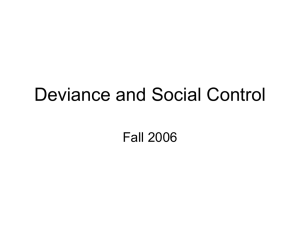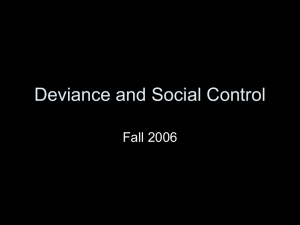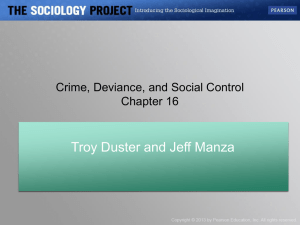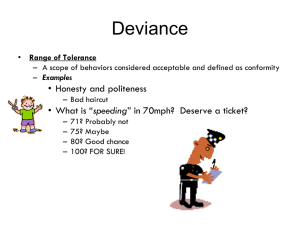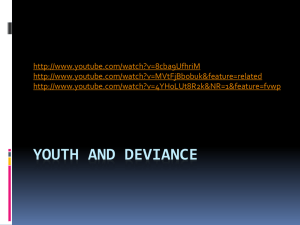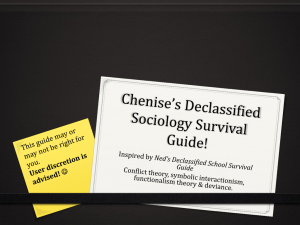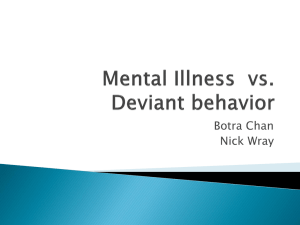Crime, Deviance and Justice
advertisement
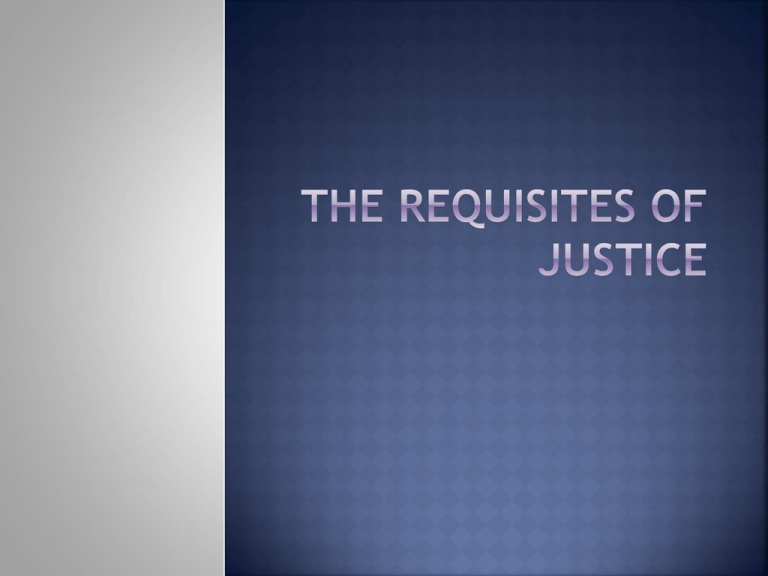
1. 2. 3. 4. The absolute ability to violators. The absolute ability to violators. The absolute ability to violators. The absolute ability to of all law violators. identify all law apprehend all law punish all law identify the intent 1. 2. 3. 4. 5. 6. 7. 8. Murder of a police officer – 2:3 (67%) Murder in general – 1:2 (50%) Aggravated Assault – 1:10 (10%) Robbery – 1:15 (7%) Burglary – 1:35 (3%) Felony Larceny 1:110 (.9%) White Collar Fraud – 1:2 million Computer Fraud – 1:120 million Absolute justice demands that all violators be punished or no violators be punished. It is inequitable to the law abridgers who are punished to allow another law abridger to roam free and unpunished. It is inequitable to the law abiders of society if known law abridgers are allowed to roam free and unpunished. 1. 2. 3. 4. Innocent are punished. Guilty escape punishment. Guilty are punished more severely than they should be. Guilty are punished less severely than they should be. There is a general socio-economic clustering of the four classic justice delivery errors, with the general convergence of error as follows: A. Poor: 1. Innocent being punished; and 2. Being punished more severely than they should be. B. Wealthy: 1. Escaping punishment when guilty; and 2. Being punished less severely than they should be. Justice is the interest of the stronger vs. Justice should be, the equitable access and applicability of rights, privileges and opportunities All governments that have flourished since the beginning of time have been nothing more than a conspiracy of the rich to perpetuate themselves under the guise of Statecraft. Thomas More (circa 1530) Who is not a criminal? Those who have not been caught. Those who possess a high socio-economic, political, legal efficacy coefficient. Who are the criminals? Those who have been caught Those who have a low socio-economic, political, legal efficacy coefficient. 1. Substantive dimension (legislative component, executive orders, court precedents) 2. Procedural dimension (line level police decision, local police, prosecutorial and judicial department policy and practice; local legal culture) Unfounding – Systematically ignoring crimes known to exist (Atlanta vs. St. Louis, Chicago). Founding – Systematically reporting crimes that otherwise would have not been reported (Portland). De-founding – systematically adjusting the severity of offenses that are known to exist (Washington, D.C.). Deviance – acts Deviants – people Emile Durkheim (1858-1917) 1. Deviance is a two-edged sword of equivalent positive and negative values. 2. “Deviant” tends to be an allencompassing label, but no one is deviant in all aspects of their lives. 3. The definition of “deviant” is contextual. It is the quintessential relativity. We are deviant when we are in a group that is different from us. Deviance and deviants depends upon who you ask and in what setting or context you are in. We are all “the deviants” in someone else’s eyes. 4. While there is some consensus at the extremes, there is little consensus beyond those edges. Definitions depend upon values, culture, perspectives, and experience. Definitions of deviance are a relative, normative phenomenon. What is deviance and who are the deviants depends upon who you ask, and when you ask it and in what context. We are all the deviants in someone else’s eyes. Multiple perceptions of deviance are held by different people with different backgrounds and experiences, and these perceptions are subject to continual change over time. These varying and fluid perceptions co-exist and compete for prominence in society, and if you have the power, you can elevate your perception to a position of prominence and have it serve as the society’s socio-legal definition of deviance, and it will stay that way until you are out of power and then someone else’s definition will emerge supreme. The definition of deviants and deviance is the ultimate, the quintessential examples of relativity. 5. Were all deviants (and their deviance) to be eliminated, new definitions of deviance would emerge and punishment would be meted out accordingly. What was marginal deviance before would now be in the unacceptable category. Deviance cannot be eliminated. The extent of deviance is constant (the constancy dictum). What changes is the definition of the nature of deviance. As societies evolve, as the interests of the powerful change, the definitions of deviance change, but the extent does not. 6. Crime is bound by social class. The poor are more criminal than the rich because the laws are both written and enforced for the benefit of the rich and powerful. Deviance is also bound by social class, not in terms of extent, but in terms of nature. In other words, the prevalence or extent of deviance is similar from one social class to another, but the types of offenses committed, the nature of deviance, differs from one social class to another (ie., the rich steal in ways available to them and the poor do likewise). The rich are less criminal than the poor simply because they have the power to define crime so as to legitimize their illicit Behaviors, and have the law enforced to their liking, but they are no less deviant in terms of the extent of their involvement in illicit behaviors. The nature of their involvement is different (the rich can steal in ways the rest of us can’t), but the extent of their involvement is the same. 7. There is a value to deviance. Remember, it is a two-edged sword with both positive and negative components (yin and yang). On the positive side, deviance: a. Serves as a catalyst for change and progress. b. Provides the raw materials for social change. c. Forces a re-examination and modification of values and behaviors in the context of new environments. d. Redistributes opportunities for leadership. e. It forces the opposition to better prepare its case and thus in this adversarial context, refines the truth. f. Responses to deviance inculcate into members of society, just what society expects. g. Draws people together in mutual condemnation, thus promoting community cohesion. h. Removes bureaucratic red-tape and thus provides quicker responses. Without deviance, we would be a society of clones with “hemophiliacic” minds, incapable of dealing with the variation around us. Deviance and diversity are mandatory to confront and survive in the tumultuous world in which we live. But, how much and what types? There is no “answer.” It is the quintessential, eternally unresolvable query. It depends on who you ask and when you ask and who is in power and who is out of power, and even then, the answer will be different tomorrow than it was today. 1. 2. Yes, by having the legislative bodies fail to function (substantively) Yes, by have the police fail to function and report (procedurally). So yes, but, that is not the point. 1. 2. 3. No, we cannot eliminate deviance anymore than a physician can eliminate death. It is always with us. We can, however, change the nature of deviance - we can reduce the severity of the nature of deviance. A. Gun/knife example (extent constant, nature changed) B. Medical analogy (reduce seriousness of disease) It is our job as criminologists to find ways to reduce the severity of the nature of crime/deviance (financial planner analogy – enhance individually unique portfolios) Crime Control Model Due Process Model Aggravates long-term stability Aggravates short term contingencies Apprehend the guilty Protect the innocent Assumes deviance and explains conformity Assumes conformity and explains deviance Authoritarian, trained police Social service, educated police Burden of proof on defense to demonstrate Burden of proof on prosecutor to demonstrate innocence at beyond reasonable doubt guilt at reasonable doubt Closed bureaucratic justice structures Open, linking-pin justice structures Corporal punishment Non-interventionist treatment Criminal intent of little concern Criminal intent of an overriding concern Discretionary power to police and prosecutorial Discretionary power to judicial and correctional officials officials Emphasis on efficiency Emphasis on effectiveness Emphasis on training Emphasis on education Few confession extraction guidelines Completely voluntary confessions Few search and seizure rules Strict search and seizure rules Frequent use of the death penalty Abolition of the death penalty Harm, frighten, scare, intimidate Encourage, help, aid, assist Harms innocent persons Allows known guilty to go free Harsh sentences Lenient sentences High certainty of apprehension/justice system Low certainty of apprehension/justice system processing processing Large, demeaning prisons Community-based corrections Crime Control Model Due Process Model Large private sector police force Small private sector police force Legal counsel provided on rare occasions Legal counsel provided as a right at all stages Maintain the status quo Respond to social inequities Mandatory, determinate sentencing Indeterminate sentencing Many law enforcement officers Few law enforcement officers Many penalties Few penalties Maximize level of offender intrusion into system Minimize level of offender intrusion into system National, centrally organized police force Local, autonomous, decentralized police force No pretrial discovery for defense Unlimited pretrial discovery for defense Plea bargaining emphasis Complete adjudication Presumption of guilt Presumption of innocence Preventive deterrence policy Curative rehabilitation policy Protect society from evolutionary change Protect society from revolutionary change Protect society in the short run Protect society in the long run Punish the guilty Protect the innocent Punishment fits the crime Punishment fits the criminal Quick, informal justice Formalized, individualized justice Rational, economic man theory Crime a psycho-sociological entity Social order Individual liberty Supervision of offenders Advocate of offenders Swift, certain punishment Treatment, but only when needed Premise #1 - When liberty is permitted to grow without limits, it is at the expense of justice and order. Premise #2 - The greatest threat to our republic comes from those, who in attempt to preserve order, would destroy liberty. Justice will be realized only when the body politic are internally willing to obey the unenforceable. What types of protections, freedoms and rights should be given to what groups of people? How extensive should they be? When does the exercise of these protections and freedoms begin to flaunt the law? When does governmental control become excessive intervention? How much liberty is to be afforded to members of society and how much order should the state seek to maintain? www.unl.edu/eskridge/cj101liberty.html The real test of life is to be able to hold two opposing ideas in mind at the same time, and still retain the ability to function. One must recognize that things are hopeless, but be determined to make them otherwise. It is on this premise that we must continue.

